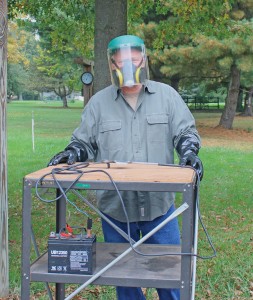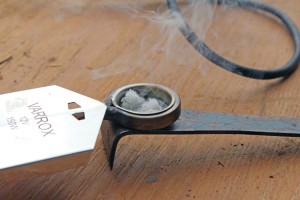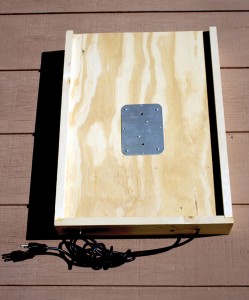Microfiber towels and small hive beetles
Some useless comments about the iconic hive smoker
J. Tew novice – Vaporizing oxalic acid; Field testing an experimental beehive heating system
Goldenrod – is it the real deal?
For the Brand New Beekeeper (Are screened bottom boards necessary?)
Odds and Ends1by James E. Tew

Microfiber towels and Small Hive Beetles
Somewhere within the past decade, I was innocently introduced to microfiber cloth. I have no memory of my first use of these towels. It was uneventful. Today, these towels are widely used in the automobile detailing and cleaning industry, but this synthetic cloth, made from fibers with a diameter far smaller than the diameter of a human hair, can be used to make everything from basketballs to Sunday suits. The polishing cloths have an odd feeling and seem to cling to my hands and fingers. While not an unpleasant feeling, I can say that it is a slightly weird feeling.
One of their many uses is a dry polish cloth. I use them on many everyday items. I polish the screen on my phone. I clean my eyeglasses with them. I wipe my grandkids fingerprints from my computer screen. Occasionally, I actually use them for one of their original purposes – cleaning automobile windshields. Until I was recently introduced to the idea at the 2015 fall meeting of the Alabama Beekeepers Association, I had never thought about using them in a beehive.
An entourage of beekeepers brought Larry W. to show me a procedure he has used that seems to work. He puts strips of microfiber cloth on the top bars of his beetle-infested hive and checked them occasionally. Interestingly, in addition to trapping a few bees, he trapped a LOT of beetles. He said that this was not specifically his idea. He thought that he had seen a posting on Facebook (or some other social media posting) where this idea was entertained.

A small hive beetle trapped in microfibers
While I love the simplicity of the idea, the fact is that we only know the cloth caught some beetles and a few bees. We don’t know how many beetles were unaffected in the colony. We don’t know how many cloths to use or precisely where to put them within the hive. Some thought was given to putting them on the bottom board, but there was concern that they would capture too many bees. Put pieces in the corners of the inner cover? Maybe put some along the edges of the bottom board? Probably use them in conjunction with other beetle traps – right? While this may or may not work out, the procedure is simple, non-toxic and cheap.
I originally thought that when the cloth was finished, it could simply be burned in the smoker. DO NOT do that. When burned, this cloth emits toxic vapors and will readily burn. Other than tossing them in the trash and not using them for smoker fuel, can anyone think of a use for cloths that look like the one pictured?
(Thanks, Larry)

A small view of beetles trapped on a microfiber cloth.
Nice smoker article, Jim T.
Jim Thompson, who is very nearly my neighbor, and a beekeeper I have known since 1978, wrote a great article in the October 2015, Bee Culture magazine. This smoker device and the inimitable straw skep (which US beekeepers rarely ever used) are acquired trademarks of the bee industry. Jim T. did a beautiful job showing the development of these bellows-driven canisters to the bellow-driven models of today. While smokers have changed, the function of smokers has not changed much.
Simply stated, we cannot routinely work our colonies without a dependably fired smoker. I truly wish that were not the case. In reality, these devices are obnoxious and smelly – and they always have been. Too often, they are the cause of fires.

Yes, that is Jim Tew. Perpetually entertaining the neighbors.
They all work the same. A smoldering fire, deprived of oxygen, is given bottom air through a manually powered bellows. As the smoldering embers recover, smoke is presented until enough air is given to cause flames to develop. Stop giving air before that point.
After using a smoker for much of the day, my clothes, my truck, my storage barn, and I smell of bee smoke. Yes, you can mist them with sugar syrup, but if working multiple big hives quickly and efficiently, sugar syrup will not carry the day.
Since the earliest days of beekeeping, smoke has been used to subdue bees. I don’t know how the process got its start. Long ago, beekeepers developed lists of local smoker fuels that characteristically burned the way beekeepers wanted. Long lasting embers and thick white smoke are two major characteristics of a good bee smoke source. To my knowledge, only occasional scientific curiosity has been allocated to the effects of various smoke sources on both the beekeeper and the bees.
After all these hundreds (thousands?) of years, we still do not conclusively understand the effects of smoke on honey bees. Untested, but accepted answers are the only ones we have, so we continue to pass them to new generations of beekeepers. For example, “smoke masks the odors in the colony so the bees cannot communicate efficiently”.
I have no doubt that some aspect of this answer is true, but bees do have other stimuli for hive defense. After all these years of evolution, are bees still just completely incapacitated by smoke? So am I to assume that smoke to a hive is much like kryptonite to Superman?
Why does smoke work? “It (somehow) causes the bees to engorge on honey in preparation for leaving the hive for a safer location.” If this were precisely true, when a bee-infested house caught fire, the colonies within the walls would engorge on honey and abandon the cavity – probably to hang on nearby trees. In those dreadful wildfires last Summer, were bees ever seen departing the forest area for safer locations? Anyone seen that?
Additionally, according to bee literature, all this departing and engorging fills them and makes them heavy so they can’t sting as well – consequently, they are gentle and more easily workable. But during a raging fire? Hmmmm. In light of me not having anything else to suggest, I suppose so, but this answer is weak and undocumented. Are bees gentler during a heavy nectar flow because every bee is fat and well fed so they don’t defend the hive as strenuously? Where’s the survival value in that? Or could it be that more of the older bees are out on foraging sorties? I don’t know.
I wish we could replace the smoker but just as with my tinnitus, there is no idea or plan on the hive horizon. Apparently, bee smokers will be with beekeepers for a much longer time. Possibly, just genetically selecting for bees that are extremely gentle might be a better solution for future beekeepers.
Oxalic Acid and J. Tew
Because it is the flavor of the month, I bought a vaporizer and some of the oxalic acid chemical from the bee supply industry. I have read numerous instructions and studied copious advice and warnings. As is often the case, the recommendations can show a serious amount of variation. My following comments are not intended to be viewed as recommendations, but rather a bit of a fearful confession from me as I prepared to use this product. (Suppliers and beekeepers, give me a chance to get through this. I want this product to work).
The list of don’t dos on the MSDS information is formidable. Even so, the literature is extensive showing that this common natural acid will kill mites that are not protected within cells. I probably should have, but did not have these same concerns when I was using various other mite control compounds. When applying other compounds, I wore plastic gloves, and if possible, I did not breathe direct vapors (That was easy with applying formic acid. Breathing it was not as option.). Finally, I removed and discarded these earlier spent materials.
Not wishing to do harm or kill my bees, I have attempted some dry runs to see how this product works. I did this without a bee or hive in sight. I have not done and do not wish to do an evaluation of the various vaporizing devices. In the photo, the name shows but that is only because it was the only one available when I purchased mine. Even so, it does seem to be well made.

Oxalic acid vaporizing.
Suiting up took me back to my earliest days of beekeeping. Full bee suit, gloves, veil and 125 feet of duct tape. As we all have done, over time, we slowly used the heavy protective equipment less and less. So here in my inaugural phase of oxalic use, I suited up. It’s embarrassing, but have a look. Tell me this look is not the future of beekeeping!
I measured out the prescribed amount and attached the leads. For maybe two minutes, nothing, but then a wisp of smoke. Complete vaporization took only about five to seven minutes, but that is not science. I have only performed this procedure a few times. The instructions say to let it go ten minutes. I was surprised at the amount of smoke that it gave off. I did get minor whiffs through my respirator, and it clearly was not pleasant breath. It had the sensation I get when I get a whiff of formic acid.
I have experienced presenters coming to the Alabama Cooperative Extension System Spring Symposium next spring to discuss this topic. By then I look forward to having a bit of introductory Winter experience with this procedure.
Importantly, check your state regulations before using. Oxalic acid use for Varroa control is not yet approved in all states. I have posted a video showing the general function of the vaporizing procedure2.
A Heated Bottom Board Prototype
A.M., a talented Alabama beekeeper who is also an engineer, has developed a heated bottom board prototype. He asked that I bring one to Ohio and use it during the Winter. I was eager to do that. It is only in the development phase and no doubt changes will be needed, but at least he has developed working prototypes. Even though A.M. said I could give some particulars, I think it more appropriate that he and I have a look this Winter and see how it goes. Out of respect for his ideas and time input, I have produced a photo that is slightly out-of-focus so that you can see the extent of his effort but not clearly see everything.

Heat generating device and temperature probes.
The top of the unit is clean and unobstructed. The temperature probe senses the air and determines the need for heat. The system is 120V reduced to 12 V. No matter what the results are, tinkering with this device will be enjoyable during the winter months.
Is Goldenrod The Real Deal?
This discussion will probably get my rear handed to me in a bag. I know there are many varieties of golden rod and all varieties in all places do not exhibit the same nectar flow characteristics.
Regardless, my goldenrod is now gone for the season. The aged plants are still there, but they are giving it up for the upcoming Winter. As is so typical (even enjoyable), just a few weeks ago my apiary was filled with the aroma of goldenrod nectar coming in.
But here’s my question. Yes, there were bees on goldenrod surrounding my apiary, but not by the thousands. I boldly told new beekeepers last month to enjoy the Autumn experience, but something nags me. To make a surplus honey crop with an aroma that fills the surrounding area shouldn’t there be thousands of bees rather than just the few hundred that I observed. Not just this season, but for many I have noted how many other insect species were all over the plants, but only a modest number of honey bees. Other Asters or other plants are involved. How much?
Just a week or so later, white aster3 was very attractive to all kinds of insect foragers. I wish I had looked at it during the goldenrod bloom – maybe it was not in bloom then. I sense that it must be from goldenrod. Maybe since there is so much of the bloom available and a limited supply of honey bees, the actually number on any plant is minimal. But, the same is true of the abundance of White-Heath Aster. Honey bees are buzzing all over this plant’s blossoms. I made a video that I posted elsewhere4. Next year, I will be on this a bit more.
For the Beginner – Screened Bottom Boards
I have never been wild about screened bottom boards, but they seem to be here stay. They play a minor role in Varroa control, but they do plan a role. They can be seasonally opened or closed. The tray can be useful when assaying mite populations that drop out due to a treatment or natural fall.

Heat generating device and temperature probes.
They are lightweight and, in my opinion, are not heavy enough for frequent hive moves. I can give them an “ok” but I cannot say that they are absolutely critical for Varroa control. If you see either at an estate auction or in the want ads, buy it if the price is right. Either style of bottom board works the same. I can’t eagerly recommend that the screened bottom board should be exclusively used. You decide.
Odds and Ends
Beekeepers have always been innovators. Hardly a century ago, the apicultural, academically trained bee scientist was only an infant. Insightful innovators –educated, but not specifically scientifically trained beekeepers – were the developers of our industry. A.I. Root, C.C. Miller, Doolittle and oh so many more laid our foundation.

White aster, a smorgasbord for insect foragers.
I enjoy describing the efforts of clever beekeepers – even if some of their efforts are unsuccessful – as they try to improve our relationship with the bees. I have described a couple in this month’s piece. A few issues ago, I asked about hive stands and received numerous descriptions and photos. Modern beekeepers are currently in the best position to be clever and creative. Exploratory beekeepers are a critical aspect of our evolving industry. They address the topics that specifically search for answers to the issues of today’s beekeeper. Good Job!
Dr. James E. Tew, State Specialist, Beekeeping, The Alabama Cooperative Extension System, Auburn University; Emeritus Faculty, The Ohio State University. Tewbee2@gmail.com; http://www.onetew.com; One Tew Bee RSS Feed (www.onetew.com/feed/); http://www.facebook.com/tewbee2; @onetewbee Youtube: https://www.youtube.com/user/onetewbee/videos








